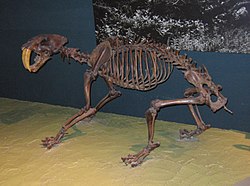
Back Smilodon Afrikaans سميلودون Arabic Саблезъби тигри Bulgarian Tigr dent sabrenn Breton Smilodon Catalan Smilodon CEB سمایلەدۆن CKB Smilodon Czech Smilodon Danish Smilodon German
| Smilodon Temporal range: Pleistocene
| |
|---|---|

| |
| Smilodon fatalis skeleton: National Museum of Natural History, Washington DC. | |
| Scientific classification | |
| Kingdom: | Animalia
|
| Class: | |
| Order: | |
| Family: | |
| Subfamily: | |
| Genus: | †Smilodon Lund, 1842
|
| Species | |
|
†Smilodon fatalis; | |
Smilodon was a genus of saber-toothed cat. There were three species.[1] Smilodon gracilis (or S. fragilis) was the ancestral, smaller, species (2.5 to 0.5 million years ago).
Smilodon populator (1 mya to 10 kya) was a large, heavy species from eastern South America. It was 1.2 m high at the shoulder, 2.1 m (83 in) long on average. With an estimated weight of 220 to 400 kg, it was among the heaviest known felids.[2] Its upper canines reached 28 cm (11 in) and protruded up to 17 cm (6.7 in) out of the upper jaw.
Smilodon fatalis (or S. californicus; 1.6 mya to 10,000 years ago) was the famous cat known from the Rancho La Brea tar pits in Los Angeles.[3] The tar, a bit like asphalt, has yielded about a million bones of late Pleistocene mammals, of which 162,000 bones are from Smilodon, representing perhaps 1200 individuals. The cat was about the size of a female lion, but weighed more, perhaps 200 kg.[4] It was about 1 metre tall at the shoulders.
- ↑ Turner A. 1997. The big cats and their fossil relatives. Columbia N.Y.ISBN 0-231-10229-1
- ↑ Christiansen P. and Harris J.M. 2005. Body size of Smilodon (Mammalia: Felidae). J. Morphology 266, 369–384. online[permanent dead link]
- ↑ The Rancho La Brea tar pits are in Hancock Park in the heart of Los Angeles. The specimens are displayed in the George C. Page Museum in the park.
- ↑ African female lions average weight: 120kg.